Sensitivity Enhanced Ecofriendly UV Spectrophotometric Methods for Quality Control of Telmisartan and Benidipine Formulations: Comparison of Whiteness and Greenness with HPLC Methods
Abstract
1. Introduction
2. Materials and Methods
2.1. Preparation of Standard Solutions and Laboratory Mixed Solution
2.2. Procedure for Each Method
2.2.1. Second Derivative Method (SDM)
2.2.2. Ratio Amplitude Difference Method (RAD)
2.2.3. Ratio First Derivative Method (RFD)
2.2.4. Constant Subtraction Method (CSM)
2.2.5. Procedure for Laboratory Mixed Solutions
2.3. Procedure for Pharmaceutical Dosage Form
3. Results and Discussion
3.1. Second Derivative Method (SDM)
3.2. Ratio Amplitude Difference Method (RAD)
3.3. Ratio First Derivative Method (RFD)
3.4. Constant Subtraction Method (CSM)
3.5. Method Validation
3.5.1. Linearity and Concentration Ranges
3.5.2. Limit of Detection (LOD) and the Quantification (LOQ)
3.5.3. Accuracy and Precision
3.5.4. Selectivity
3.5.5. Ruggedness
3.6. Application of Proposed Methods for Assay of Solid Dosage Form
3.7. Evaluation of Environmental Sustainability
3.7.1. Analytical GREEnness Metric Approach (AGREE)
3.7.2. White Analytical Chemistry Assessment Technique (12 RGB Design)
4. Conclusions
Supplementary Materials
Author Contributions
Funding
Institutional Review Board Statement
Informed Consent Statement
Data Availability Statement
Acknowledgments
Conflicts of Interest
References
- Zhou, B.; Perel, P.; Mensah, G.A.; Ezzati, M. Global epidemiology, health burden and effective interventions for elevated blood pressure and hypertension. Nat. Rev. Cardiol. 2021, 18, 785–802. [Google Scholar] [CrossRef] [PubMed]
- Zhou, B.; Carrillo-Larco, R.M.; Danaei, G.; Riley, L.M.; Paciorek, C.J.; Stevens, G.A.; Gregg, E.W.; Bennett, J.E.; Solomon, B.; Singleton, R.K.; et al. Worldwide trends in hypertension prevalence and progress in treatment and control from 1990 to 2019: A pooled analysis of 1201 population-representative studies with 104 million participants. Lancet 2021, 398, 957–980. [Google Scholar] [CrossRef]
- Gradman, A.H.; Parisé, H.; Lefebvre, P.; Falvey, H.; Lafeuille, M.-H.; Duh, M.S. Initial Combination Therapy Reduces the Risk of Cardiovascular Events in Hypertensive Patients: A matched cohort study. Hypertension 2013, 61, 309–318. [Google Scholar] [CrossRef] [PubMed]
- Umemoto, S.; Ogihara, T.; Matsuzaki, M.; Rakugi, H.; Shimada, K.; Kawana, M.; Kario, K.; Ohashi, Y.; Saruta, T.; The Combination Therapy of Hypertension to Prevent Cardiovascular Events (COPE) Trial Group. Effects of Calcium-Channel Blocker Benidipine-Based Combination Therapy on Cardiac Events—Subanalysis of the COPE Trial. Circ. J. 2018, 82, 457–463. [Google Scholar] [CrossRef] [PubMed]
- Umemoto, S.; Ogihara, T.; Matsuzaki, M.; Rakugi, H.; Ohashi, Y.; Saruta, T.; Ogihara, T. Effects of calcium channel blocker benidipine-based combination therapy on target blood pressure control and cardiovascular outcome: A sub-analysis of the COPE trial. Hypertens. Res. 2016, 40, 376–384. [Google Scholar] [CrossRef] [PubMed][Green Version]
- Abe, M.; Okada, K.; Maruyama, N.; Matsumoto, S.; Maruyama, T.; Fujita, T.; Matsumoto, K.; Soma, M. Comparison between the antiproteinuric effects of the calcium channel blockers benidipine and cilnidipine in combination with angiotensin receptor blockers in hypertensive patients with chronic kidney disease. Expert Opin. Investig. Drugs 2010, 19, 1027–1037. [Google Scholar] [CrossRef]
- Yao, K.; Nagashima, K.; Miki, H. Pharmacological, Pharmacokinetic, and Clinical Properties of Benidipine Hydrochloride, a Novel, Long-Acting Calcium Channel Blocker. J. Pharmacol. Sci. 2006, 100, 243–261. [Google Scholar] [CrossRef]
- Ohno, T.; Kobayashi, N.; Yoshida, K.; Fukushima, H.; Matsuoka, H. Cardioprotective Effect of Benidipine on Cardiac Performance and Remodeling in Failing Rat Hearts. Am. J. Hypertens. 2008, 21, 224–230. [Google Scholar] [CrossRef]
- Deppe, S.; Böger, R.H.; Weiss, J.; Benndorf, R.A. Telmisartan: A review of its pharmacodynamic and pharmacokinetic properties. Expert Opin. Drug Metab. Toxicol. 2010, 6, 863–871. [Google Scholar] [CrossRef]
- Rosario, B.H.; Hendra, T.J. Telmisartan in the treatment of hypertension. Expert Opin. Drug Metab. Toxicol. 2008, 4, 485–492. [Google Scholar] [CrossRef]
- Benndorf, R.A.; Böger, R.H. Pleiotropic effects of telmisartan: Still more to come? J. Hypertens. 2008, 26, 854–856. [Google Scholar] [CrossRef] [PubMed]
- Pendhari, S.S.; Ghuge, B.S.; Malode, P.A.; Anantwar, S.P. UV-Visible Spectrophotometric Method Development and Validation of Assay of Benidipine Hydrochloride Tablet Formulation. Indo Am. J. Pharma. Res. 2017, 7, 8159–8168. [Google Scholar]
- Buridi, K.; Shantiswarup, L.; Raghubabu, K. Validated visible spectrophotometric methods development for the determina-tion of benidipine hydrochloride based on complex and internal salt formation reactions. Int. J. Inst. Pharma. Life Sci. 2012, 2, 25–33. [Google Scholar]
- Kumar, M.; Shukla, A.K.; Bishnoi, R.S.; Jain, C.P. Development of UV Spectrophotometric Method for the Determination of Benidipine Hydrochloride by Using Quality by Design (QbD) Approach. Int. J. Appl. Pharm. 2018, 10, 92–97. [Google Scholar] [CrossRef]
- Malek, S.; Prajapati, L.; Joshi, A.; Kharodiya, M. Spectrophotometric method for the determination of benidipine hydrochlo-ride in pharmaceutical formulation. Trop. J. Pharm. Life Sci. 2018, 5, 1–7. [Google Scholar]
- Karasaka, A. First order derivative spectrophotometric method for the determination of benidipine hydrochloride pharmaceutical preparations and forced degradation study. Opt. Spectrosc. 2015, 118, 1002–1006. [Google Scholar] [CrossRef]
- Önal, C.; Tekkeli, Ş.E.K. Spectrofluorimetric determination of benidipine in pharmaceutical preparation and spiked plasma samples using 7-fluoro-4-nitrobenzo-2-oxa-1,3-diazole. J. Res. Pharm. 2019, 23, 1060–1066. [Google Scholar] [CrossRef]
- Jagadeesh, K.; Annapurna, N. Stability Indicating Method to Analyze Benidipine and Chlorthalidone Using HPLC Technique: Establishment, Validation and Application to Tablets. Pharm. Sci. 2020, 26, 75–81. [Google Scholar] [CrossRef]
- Patel, D.; Patel, D.; Patel, A.; Sheth, A.; Shah, U. Method Development and Validation for Simultaneous Estimation of Beni-dipine Hydrochloride and Metoprolol Succinate in Tablet. J. Drug Dev. Tech. 2019, 9, 28–33. [Google Scholar]
- Kang, W.; Yun, H.-Y.; Liu, K.-H.; Kwon, K.-I.; Shin, J.-G. Determination of benidipine in human plasma using liquid chromatography–tandem mass spectrometry. J. Chromatogr. B Analyt. Technol. Biomed. Life Sci. 2004, 805, 311–314. [Google Scholar] [CrossRef]
- Kang, W.; Lee, D.-J.; Liu, K.-H.; Sunwoo, Y.E.; Kwon, K.-I.; Cha, I.-J.; Shin, J.-G. Analysis of benidipine enantiomers in human plasma by liquid chromatography–mass spectrometry using a macrocyclic antibiotic (Vancomycin) chiral stationary phase column. J. Chromatogr. B 2005, 814, 75–81. [Google Scholar] [CrossRef] [PubMed]
- Rathod, S.D.; Patil, P.M.; Waghmare, S.S.A.; Chaudhari, P.D. UV-Spectrophotometric Method for Estimation of Telmisartan in Bulk and Tablet Dosage Form. Int. J. Pharm. Sci. Res. 2012, 3, 3936–3939. [Google Scholar] [CrossRef]
- Attimarad, M.; Chohan, M.S.; Elgorashe, R.E.E. Smart analysis of a ternary mixture of amlodipine, hydrochlorothiazide and telmisartan by manipulation of UV spectra: Development, validation and application to formulations. J. Mol. Struct. 2020, 1212, 128095. [Google Scholar] [CrossRef]
- Elshanawane, A.A.; Abdelaziz, L.M.; Kamal, M.M.; Hafez, H.M. Quantitative Determination of Telmisartan, Ramipril, Amlodipine Besylate, and Atorvastatin Calcium by Hplc. J. Liq. Chromatogr. Relat. Technol. 2013, 37, 195–206. [Google Scholar] [CrossRef]
- Attimarad, M.; Venugopala, K.; Sreeharsha, N.; Chohan, M.; Shafi, S.; Nair, A.; Pottathil, S. A Rapid HPLC Method for the Concurrent Determination of Several Antihypertensive Drugs from Binary and Ternary Formulations. Separations 2021, 8, 86. [Google Scholar] [CrossRef]
- Patil, K.R.; Shinde, D.B. Stability—Indicating LC Method for the Simultaneous Determination of Telmisartan and Hydrochlorothiazide in Dosage Form. J. Chil. Chem. Soc. 2012, 57, 1017–1021. [Google Scholar] [CrossRef][Green Version]
- Panchal, J.G.; Patel, R.V.; Mistry, B.R.; Menon, S.K. Development and Validation of Reversed-Phase LC Method for Simul-taneous Determination Telmisartan, Amlodipine and Their Degradation Products in Fixed Dose Combination Tablets. Eurasian J. Anal. Chem. 2012, 7, 28–42. [Google Scholar]
- Ilango, K.; Pushpangadhan, S.; Kumar, S. Development and Validation of Stability Indicating HPTLC and HPLC Methods for Simultaneous Determination of Telmisartan and Atorvastatin in Their Formulations. J. Chem. 2013, 2013, 1–9. [Google Scholar] [CrossRef]
- Wang, B.; Sheng, L.; Li, Y. Simultaneous Determination of Telmisartan and Amlodipine in Dog Plasma by LC–MS-MS. J. Chromatogr. Sci. 2015, 53, 1708–1713. [Google Scholar] [CrossRef]
- Li, P.; Wang, Y.; Tang, Y.; Fawcett, J.P.; Cui, Y.; Gu, J. Determination of telmisartan in human plasma by liquid chromatography–tandem mass spectrometry. J. Chromatogr. B Analyt. Technol. Biomed. Life Sci. 2005, 828, 126–129. [Google Scholar] [CrossRef]
- Adriana, M.; Gabriel, H.; Alepandru, V.R.; Ștefana, S.; Rupandra, S.; Hajnal, K. Simultaneous determination of amlodipine and telmisartan from pharmaceutical products by way of capillary electrophoresis. Curr. Issues Pharm. Med. Sci. 2016, 29, 42–46. [Google Scholar] [CrossRef]
- Chandgude, V.; Dyade, G.K.; Jadhav, R. Stability Indicating Validated RP-HPLC Method Development for Simultaneous Estimation of Benidipine Hydrochloride and Telmisartan from Pharmaceutical Dosage Form. Int. J. Sci. Res. 2019, 8, 767–773. [Google Scholar] [CrossRef]
- Jain, P.G.; Chaudhry, A.B.; Bhadani, S.M. Development and validation of RP-HPLC method for simultaneous estimation of Benidipine hydrochloride and Telmisartan in tablet. World J. Pharm. Pharm. Sci. 2018, 7, 751–762. [Google Scholar] [CrossRef]
- Naim, M.; Ahmed, A.; Gj, K. Stability indicating reverse-phase high- performance liquid chromatography method development and validation for simul-taneous estimation of Telmisartan and Benidipine hydrochloride in pharmaceutical dosage form. Asian J. Pharm. Clin. Res. 2018, 11, 342–350. [Google Scholar] [CrossRef]
- Patel, B.; Chaudhary, A.; Gami, S. RP-HPLC Method Development and Validation for Simultaneous Estimation of Benidipine Hydrochloride, Telmisartan and Chlorthalidone in Tablet. JETIR 2019, 6, 15. [Google Scholar]
- Kamal, A.H.; El-Malla, S.F.; Hammad, S.F. A Review on UV spectrophotometric methods for simultaneous multicomponent analysis. Eur. J. Pharm. Med. Res. 2016, 3, 348–360. [Google Scholar]
- Salinas, F.; Nevado, J.; Mansilla, A. A new spectrophotometric method for quantitative multicomponent analysis resolution of mixtures of salicylic and salicyluric acids. Talanta 1990, 37, 347–351. [Google Scholar] [CrossRef]
- Chohan, M.S.; Elgorashe, R.E.E.; Balgoname, A.A.; Attimarad, M.; SreeHarsha, N.; Venugopala, K.N.; Nair, A.B.; Pottathil, S. Eco-friendly Derivative UV Spectrophotometric Methods for Simultaneous Determination of Diclofenac Sodium and Moxifloxacin in Laboratory Mixed Ophthalmic Preparation. Indian J. Pharm. Educ. Res. 2019, 54, 166–174. [Google Scholar] [CrossRef]
- Bhatt, N.M.; Chavada, V.D.; Sanyal, M.; Shrivastav, P.S. Manipulating Ratio Spectra for the Spectrophotometric Analysis of Diclofenac Sodium and Pantoprazole Sodium in Laboratory Mixtures and Tablet Formulation. Sci. World J. 2014, 2014, 1–10. [Google Scholar] [CrossRef] [PubMed]
- Attimarad, M.; Chohan, M.S.; Balgoname, A.A. Simultaneous Determination of Moxifloxacin and Flavoxate by RP-HPLC and Ecofriendly Derivative Spectrophotometry Methods in Formulations. Int. J. Environ. Res. Public Health 2019, 16, 1196. [Google Scholar] [CrossRef]
- Attimarad, M.; Venugopala, K.N.; Shafi, S.; Balgoname, A.A.; Altaysan, A.I. Smart Spectrophotometric Method Development for Simultaneous Estimation of Antidiabetic Drugs in Formulations. Indian J. Pharm. Educ. Res. 2022, 56, 224–231. [Google Scholar] [CrossRef]
- Attimarad, M.; Venugopala, K.N.; Al-Dhubiab, B.E.; Elgorashe, R.E.E.; Shafi, S. Development of Ecofriendly Derivative Spectrophotometric Methods for the Simultaneous Quantitative Analysis of Remogliflozin and Vildagliptin from Formulation. Molecules 2021, 26, 6160. [Google Scholar] [CrossRef] [PubMed]
- Attimarad, M.; Venugopala, K.N.; Aldhubiab, B.E.; Nair, A.B.; Sreeharsha, N.; Pottathil, S.; Akrawi, S.H. Development of UV Spectrophotometric Procedures for Determination of Amlodipine and Celecoxib in Formulation: Use of Scaling Factor to Improve the Sensitivity. J. Spectrosc. 2019, 2019, 1–10. [Google Scholar] [CrossRef]
- Mendez, A.; Cassol, J.P.E.; Camargo, V.; Malesuik, M.D.; Garcia, C. Quantitative Determination of Paliperidone in OROS® Tablets by Derivative Spectrophotometric Method—Application in Extraction and Comparison to HPLC. Curr. Anal. Chem. 2013, 10, 158–165. [Google Scholar] [CrossRef]
- Bitencourt, A.S.; Oliveira, S.S.; Mendez, A.S.L.; Garcia, C.V. UV spectrophotometric method for determination of posacona-zole: Comparison to HPLC. Rev. Ciênc. Farm. Básica Apl. 2015, 36, 491–495. [Google Scholar]
- Pena-Pereira, F.; Wojnowski, W.; Tobiszewski, M. AGREE—Analytical GREEnness Metric Approach and Software. Anal. Chem. 2020, 92, 10076–10082. [Google Scholar] [CrossRef]
- Nowak, P.M.; Kościelniak, P. What Color Is Your Method? Adaptation of the RGB Additive Color Model to Analytical Method Evaluation. Anal. Chem. 2019, 91, 10343–10352. [Google Scholar] [CrossRef]
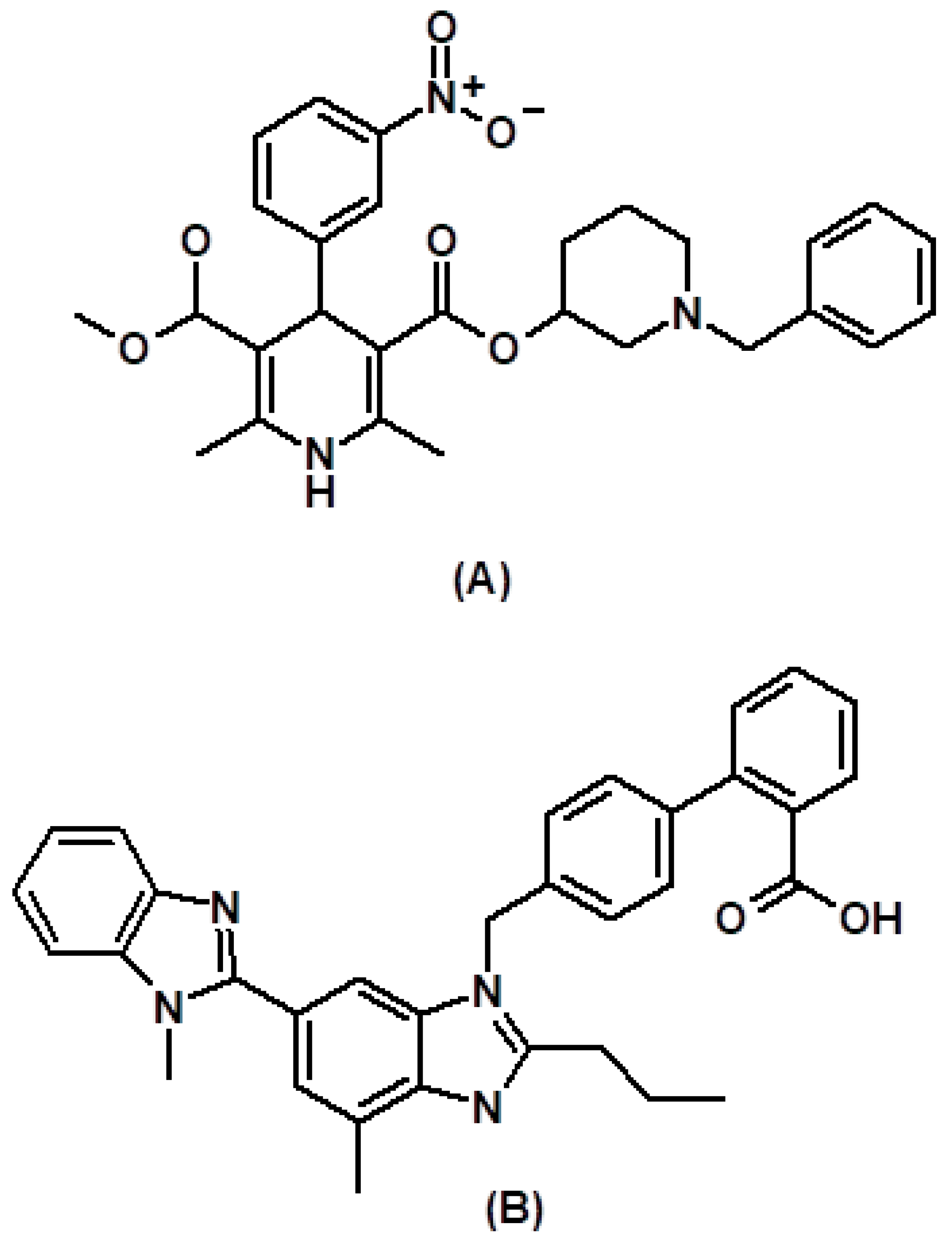
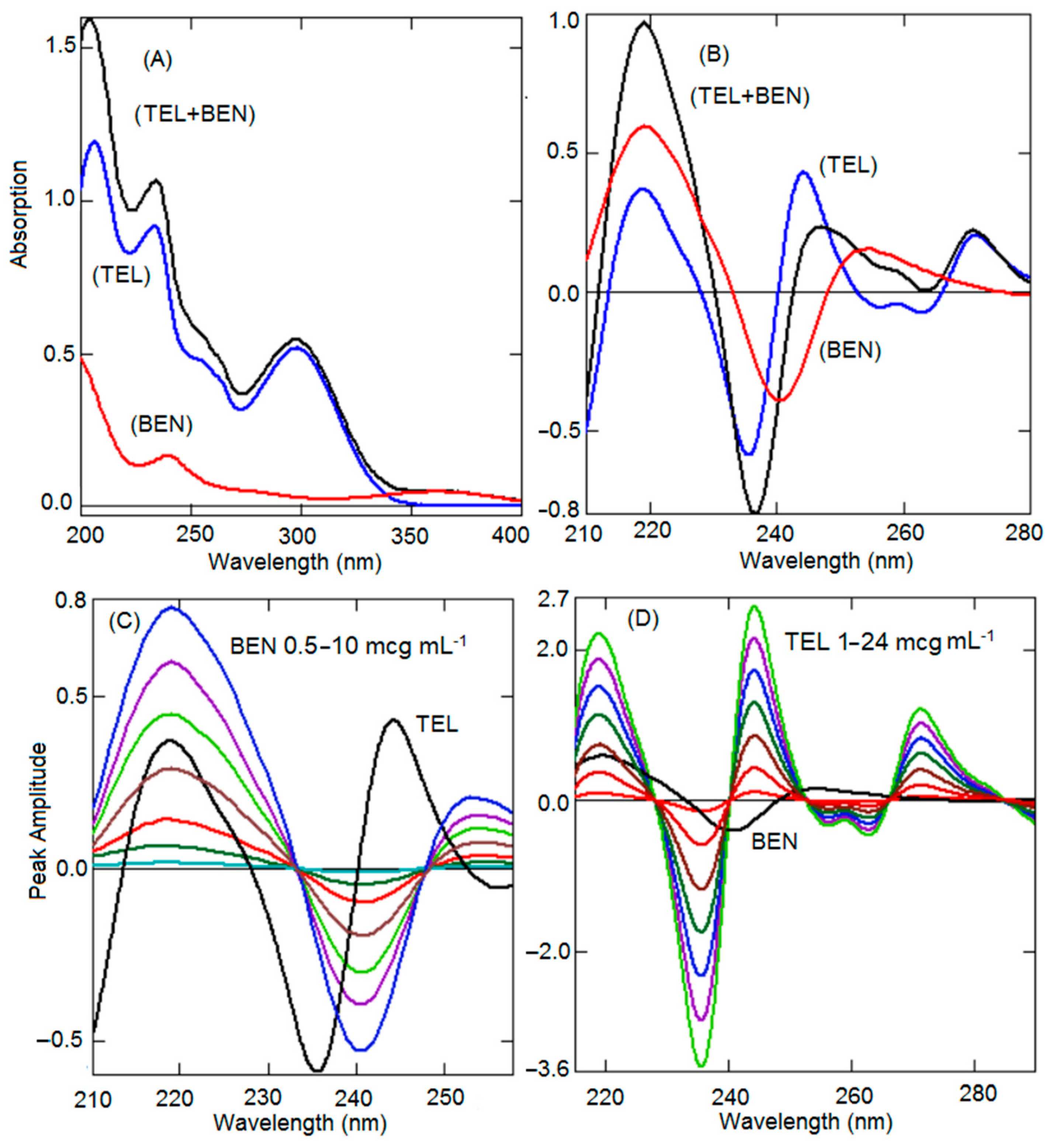
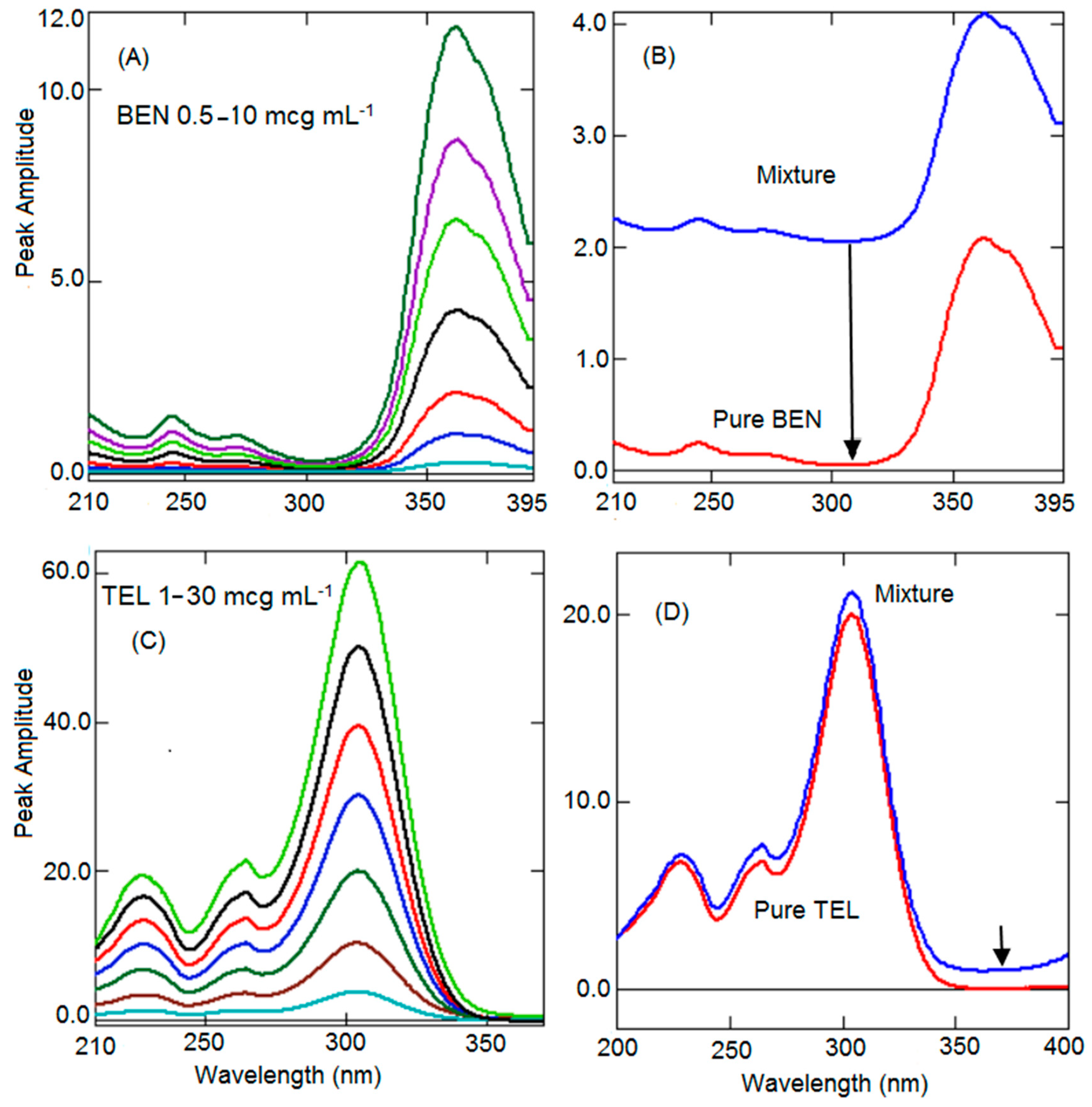

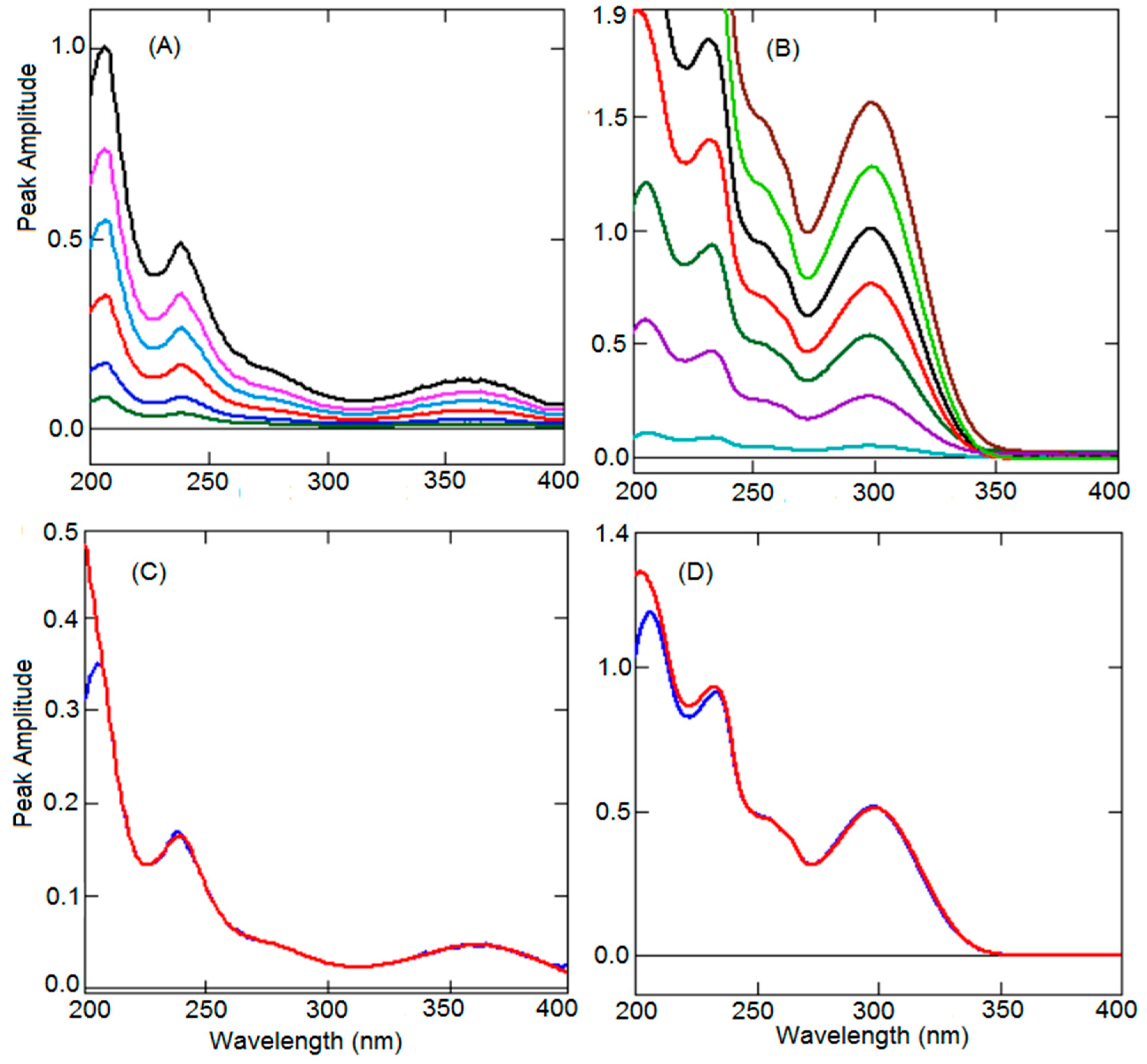
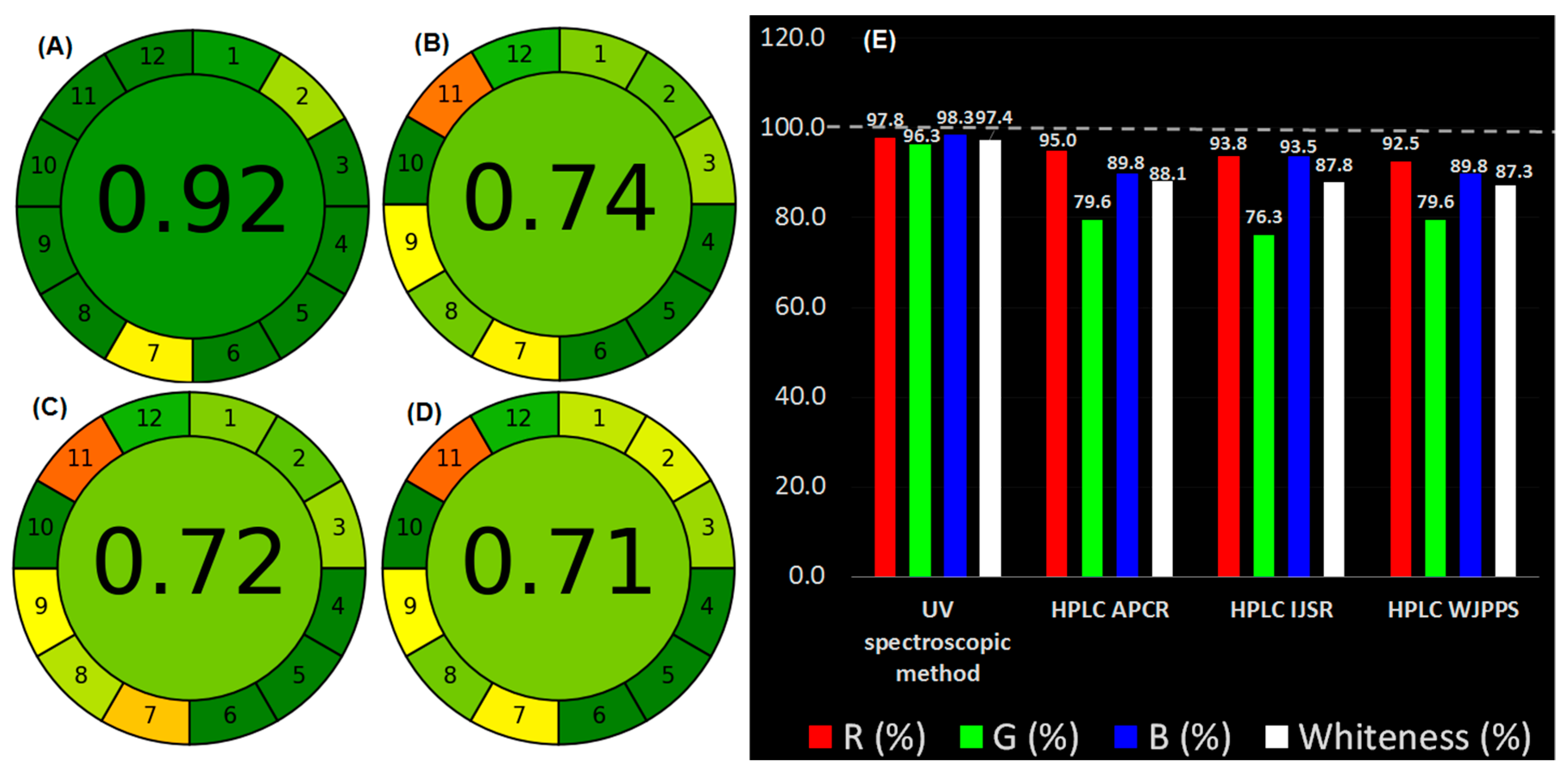
| Validation Parameters | Benidipine | Telmisartan | ||||||
|---|---|---|---|---|---|---|---|---|
| SDM | RAD | RFD | CSM | SDM | RAD | RFD | CSM | |
| Wavelength (nm) | 239.8 | 360.8–304.2 | 344.0 | 238.2 | 233.1 | 305.4–244.5 | 318.6 | 299.5 |
| Linearity range (µg mL−1) | 0.5–10 | 0.5–10 | 0.5–10 | 0.5–10 | 1–24 | 1–30 | 1–30 | 1–30 |
| Slope | 0.0509 | 1.0784 | 4.5038 | 0.0445 | 0.1068 | 1.5785 | 8.3934 | 0.0518 |
| Intercept | −0.0087 | −0.0941 | −0.4644 | −0.0062 | 0.0149 | 0.6598 | 2.6796 | −0.0089 |
| Regression coefficient (r2) | 0.9998 | 0.9998 | 0.9999 | 0.9997 | 0.9998 | 0.9997 | 0.9998 | 0.9995 |
| LOD (µg mL−1) | 0.121 | 0.088 | 0.099 | 0.139 | 0.288 | 0.287 | 0.256 | 0.268 |
| LOQ (µg mL−1) | 0.402 | 0.293 | 0.332 | 0.465 | 0.962 | 0.951 | 0.801 | 0.945 |
| Accuracy (Mean % ± RSE) | 99.61 ± 1.47 | 99.31 ± 0.94 | 100.62 ± 1.70 | 98.37 ± 1.08 | 99.35 ± 0.89 | 98.44 ± 0.83 | 99.27 ± 1.58 | 100.76 ± 0.67 |
| Precision (%RSD) | ||||||||
| Intraday | 0.864 | 1.247 | 0.679 | 0.758 | 1.471 | 0.947 | 1.622 | 0.765 |
| Interday | 1.408 | 1.353 | 0.964 | 1.796 | 1.592 | 1.203 | 1.493 | 1.531 |
| Laboratory Prepared Mixture (µg mL−1) | Benidipine (% Recovery) | Telmisartan (% Recovery) | |||||||
|---|---|---|---|---|---|---|---|---|---|
| BEN | TEL | SDM | RAD | RFD | CSM | SDM | RAD | RFD | CSM |
| 1 | 20 | 100.45 | 100.62 | 98.48 | 99.63 | 98.76 | 100.54 | 98.47 | 101.34 |
| 5 | 20 | 99.54 | 98.34 | 99.57 | 100.92 | 99.34 | 99.33 | 99.48 | 98.47 |
| 10 | 10 | 100.57 | 100.86 | 98.37 | 98.83 | 98.81 | 99.07 | 99.62 | 100.62 |
| 0.5 | 5 | 99.06 | 100.92 | 100.65 | 100.75 | 100.83 | 101.73 | 98.24 | 99.54 |
| 2 | 24 | 99.72 | 100.04 | 99.53 | 100.17 | 99.66 | 100.04 | 98.42 | 99.54 |
| Across Mean | 99.87 | 100.16 | 99.32 | 100.06 | 99.48 | 100.14 | 98.85 | 99.90 | |
| Standard Deviation | 0.76 | 0.49 | 1.14 | 0.98 | 1.01 | 1.35 | 0.75 | 0.62 | |
| Analyst | Benidipine (Mean % ± %RSD) | Telmisartan (Mean % ± %RSD) | ||||||
|---|---|---|---|---|---|---|---|---|
| SDM | RAD | RFD | CSM | SDM | RAD | RFD | CSM | |
| Analyst 1 | 99.45 ± 0.95 | 100.78 ± 1.58 | 98.27 ± 0.67 | 99.43 ± 0.72 | 100.12 ± 1.47 | 99.64 ± 1.08 | 98.06 ± 0.47 | 99.11 ± 0.93 |
| Analyst 2 | 99.07 ± 0.94 | 98.59 ± 0.85 | 99.66 ± 0.82 | 100.28 ± 0.95 | 99.53 ± 1.25 | 98.62 ± 1.06 | 99.43 ± 1.72 | 101.04 ± 1.23 |
| Formulation Concentration | Benidipine (Mean% ± SD) | Telmisartan (Mean% ± SD) | |||||||
|---|---|---|---|---|---|---|---|---|---|
| BEN | TEL | SDM | RAD | RFD | CSM | SDM | RAD | RFD | CSM |
| 4 mg | 40 mg | 98.27 ± 1.34 | 99.07 ± 0.86 | 98.61 ± 1.83 | 98.92 ± 0.95 | 99.82 ± 0.66 | 98.87 ± 0.78 | 99.06 ± 0.80 | 98.92 ± 1.05 |
| 4 mg | 80 mg | 100.14 ± 0.96 | 100.75 ± 1.34 | 98.67 ± 1.06 | 99.55 ± 0.73 | 100.49 ± 1.72 | 99.36 ± 1.49 | 101.05 ± 0.79 | 100.67 ± 1.53 |
| Standard Addition Method | |||||||||
| Amount Added (µg mL−1) | Benidipine (% Recovery) | Telmisartan (% Recovery) | |||||||
| 1 | 4 | 99.54 | 98.34 | 99.57 | 100.92 | 99.34 | 99.33 | 99.48 | 98.47 |
| 2 | 8 | 100.57 | 100.86 | 98.37 | 98.83 | 98.81 | 99.07 | 100.44 | 100.62 |
| 3 | 12 | 99.06 | 100.92 | 100.65 | 100.75 | 100.83 | 101.73 | 100.03 | 99.54 |
| Across Mean | 99.72 | 100.04 | 99.53 | 100.17 | 99.66 | 100.04 | 99.98 | 99.54 | |
| %RSD | 0.77 | 1.47 | 1.15 | 1.16 | 1.05 | 1.47 | 0.48 | 1.08 | |
Publisher’s Note: MDPI stays neutral with regard to jurisdictional claims in published maps and institutional affiliations. |
© 2022 by the authors. Licensee MDPI, Basel, Switzerland. This article is an open access article distributed under the terms and conditions of the Creative Commons Attribution (CC BY) license (https://creativecommons.org/licenses/by/4.0/).
Share and Cite
Chohan, M.S.; Attimarad, M.; Venugopala, K.N.; Nair, A.B.; Sreeharsha, N.; Molina, E.I.P.; Kotnal, R.B.; Shafi, S.; David, M.; Shinu, P.; et al. Sensitivity Enhanced Ecofriendly UV Spectrophotometric Methods for Quality Control of Telmisartan and Benidipine Formulations: Comparison of Whiteness and Greenness with HPLC Methods. Int. J. Environ. Res. Public Health 2022, 19, 7260. https://doi.org/10.3390/ijerph19127260
Chohan MS, Attimarad M, Venugopala KN, Nair AB, Sreeharsha N, Molina EIP, Kotnal RB, Shafi S, David M, Shinu P, et al. Sensitivity Enhanced Ecofriendly UV Spectrophotometric Methods for Quality Control of Telmisartan and Benidipine Formulations: Comparison of Whiteness and Greenness with HPLC Methods. International Journal of Environmental Research and Public Health. 2022; 19(12):7260. https://doi.org/10.3390/ijerph19127260
Chicago/Turabian StyleChohan, Muhammad Shahzad, Mahesh Attimarad, Katharigatta Narayanaswamy Venugopala, Anroop Balachandran Nair, Nagaraja Sreeharsha, Efren II Plaza Molina, Ramling Bhagavantrao Kotnal, Sheeba Shafi, Marysheela David, Pottathil Shinu, and et al. 2022. "Sensitivity Enhanced Ecofriendly UV Spectrophotometric Methods for Quality Control of Telmisartan and Benidipine Formulations: Comparison of Whiteness and Greenness with HPLC Methods" International Journal of Environmental Research and Public Health 19, no. 12: 7260. https://doi.org/10.3390/ijerph19127260
APA StyleChohan, M. S., Attimarad, M., Venugopala, K. N., Nair, A. B., Sreeharsha, N., Molina, E. I. P., Kotnal, R. B., Shafi, S., David, M., Shinu, P., Altaysan, A. I., & Balgoname, A. A. (2022). Sensitivity Enhanced Ecofriendly UV Spectrophotometric Methods for Quality Control of Telmisartan and Benidipine Formulations: Comparison of Whiteness and Greenness with HPLC Methods. International Journal of Environmental Research and Public Health, 19(12), 7260. https://doi.org/10.3390/ijerph19127260








